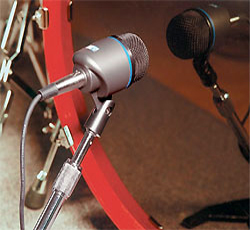
Over-dampening kills tone. Felt strips cause more trouble than good, as they keep the head from correctly tensioning.
It’s often best to only lightly dampen the heads, to control decay, and Drum Workshop makes an hourglass-shaped pillow that’s held in place with Velcro to lightly touch both heads.
Before you even turn on the kick mic, do everyone a favor and listen up close. If it doesn’t sound good acoustically, there’s little that will make it sound great in the PA, short of replacing it with a sample. (Surely the next digital mixing console trick is a built-in Wendell Jr. that plays back the drum from last night’s show or the drum from the record.)
Now hit the drum. The kick drum seems simple to play, but can seem mediocre during a line check with a tech or stagehand’s foot at work, yet suddenly sounds great when the actual drummer shows up, as long as he plays it the way he will during the show.
Properly playing a kick drum takes a well-toned leg, built up from years of bouncing the heel.
Maybe playing back a sample of a previous show’s kick is a good idea until a real drummer arrives.
Time is frequently wasted turning knobs, when a twist of the mic stand’s boom arm is what’s really needed. While the engineer is wrestling with the first input, it’s helpful to have an interested tech assist at the kit, by listening up close and standing by to adjust the drum pillow, mic angle, or simply offering suggestions about how it sounds.
Let’s look at our mic options.
Legends
Kick drum mic choices have evolved over the years. In the beginning there were few alternatives and no “kick drum” mics. There were just vocal mics and instrument mics.
Eventually a few models emerged as favorites: the venerable Sennheiser MD 421, the solid EV RE20 and the exotic but fragile AKG D 12E.
The fallback was simply a Shure SM57, and at a pinch an SM58 worked equally well, as they’re nearly identical. The old gaffe about the sound company with both kinds of mics: 58s and 57s was true back in the day, with the first exception being a special kick drum mic, where it does really matter.
The road-dog trick in the 1970s was to modify a 57 by taking the transformer out and connecting the capsule directly to the XLR, a ploy rediscovered by budget recording enthusiasts.
This modification drops the gain by 10 dB—perfect for kick drum applications—while also removing the cheap transformer that saturates upon extreme SPL. You’ll want to mark this mic so as not to confuse it, unless you end up modding all your 57s.
Old roadies can confirm that the Sennheiser 421 was first choice for years, and still is for many. I bought my first a quarter-century ago, and when I replaced it with a new one, I sold the dented old one for more than I paid for it.
Long ago they were used for vocals, so it was important to check the roll-off ring. A secret weapon is its cousin, the 441. With its tighter pattern, it rejects more stage wash and can be more easily focused onto or away from the click of the beater.

